Риторическая структура раздела «Обсуждение результатов» в обзоре предметного поля: жанровая специфика и принципы моделирования
Aннотация
Актуальность: Несмотря на то что обзоры предметного поля (scoping reviews) получили признание как самостоятельная форма научного синтеза, риторическая структура их раздела «Обсуждение результатов» остаётся теоретически недостаточно проработанной и не всегда реализуется на практике эффективно. Несмотря на растущую стандартизацию методологических процедур в рамках таких протоколов, как PRISMA-ScR и руководство JBI, риторические конвенции, регулирующие способы представления результатов и позиционирования вклада в предметную область, остаются неопределенными. Как результат, раздел Дискуссия в обзоре предметного поля является формально оформленным, но содержательно расплывчатым и перегруженным обсуждениями, которые не обеспечивают выполнение жанрово-специфической задачи (картографирования исследовательского ландшафта и выявления концептуальных, методологических и тематических лакун).
Проблема: Настоящее исследование направлено на выявление и описание риторической структуры раздела «Обсуждение результатов» в обзорах предметного поля путём разработки типологии риторических мувов и степов, а также анализа их частотности, функций и порядка следования. Анализ призван прояснить, как авторы выстраивают исследовательскую аргументацию в жанре, который не включает синтеза эмпирических данных и оценки качества литературы.
Mетоды: В качестве материала анализа использован корпус из 50 обзоров предметного поля, опубликованных в ведущих англоязычных журналах по педагогике, входящих в первый квартиль рейтинга SJR (Q1). Применялась двухуровневая схема риторического кодирования: мувы интерпретировались как макрофункции, реализующие ключевые жанровые задачи, а степы — как их конкретные микростратегии. Начальные категории мувов были выделены дедуктивно на основе существующих моделей для эмпирических исследований, после чего уточнялись и адаптировались к логике жанра scoping review в ходе итеративного анализа. Процедура кодирования осуществлялась тремя независимыми экспертами, с согласованием расхождений через интерпретативную дискуссию и аргументацию, основанную на текстовых примерах.
Результаты: Анализ позволил выделить шесть ключевых риторических мувов, характерных для раздела «Обсуждение» в обзорах предметного поля, каждый из которых выполняет отдельную коммуникативную функцию. Тогда как аналитические и оценочные мувы встречались практически во всех текстах, вводный и интерпретационный мувы демонстрировали высокую вариативность и нередко отсутствовали. Только в 24% статей была реализована полная шестиэлементная структура. Двухуровневая модель (мувы и степы) позволила зафиксировать устойчивые риторические паттерны, а также выявить типичные пропуски: отсутствие объяснений, нехватку контрастивной рамки, а также риторические заимствования из систематических обзоров, нарушающие логику жанра scoping review.
Выводы: Результаты исследования показывают, что раздел «Обсуждение результатов» в обзорах предметного поля страдает от риторической несогласованности и жанровой гибридности. При отсутствии целостной риторической структуры обсуждение рискует превратиться в повторение результатов, не обеспечивая ни интерпретации, ни полевой аналитики. Предложенная модель мувов и степов предлагает жанрово чувствительный риторический каркас, способный повысить прозрачность и аргументативную точность текстов в формате scoping review. Кроме того, модель вносит вклад в более широкое понимание принципов научной аргументации в жанрах, не ориентированных на синтез доказательств.
Ключевые слова: Раздел «Обсуждение результатов», Обзор предметного поля, Модель риторических ходов и шагов, Жанровый анализ, Аргументация в обзорных статьях, Риторические шаги в обзоре предметного поля, Конвенции научного письма
К сожалению, текст статьи доступен только на Английском
Introduction
Changes in the nature of scholarly communication and the structure of academic knowledge substantiate recent interest in scoping reviews. As research problems become more complex and the body of research in various disciplines increases, there is a growing need for tools that allow not only to identify reliable evidence, but also to understand how the research space itself is structured (Tikhonova, 2024): which topics have already been explored, which are in early stages of scholarly development, where gaps are identified and how methodological approaches are distributed. Scoping reviews respond to this request, providing the opportunity for a structural analysis of literature without striving for a general synthesis (Grant, Booth, 2009; Moher et al., 2015; Tricco et al., 2016; Peters at al., 2020). This approach is especially in demand in new and interdisciplinary fields where the systematic evidence base is still insufficient, but material has already been accumulated that allows identifying trends and patterns in the development of the field (Arksey, O’Malley, 2005; Levac et al., 2010; Khalil et al., 2016). Due to this versatility and extensive coverage, scoping reviews are actively used both in academic research and in applied analytics, namely, at the stages of preliminary design, formation of research programmes and expert assessment of knowledge.
Despite their methodological affinity with a systematic review (both formats rely on similar procedures for searching, selecting, and documenting sources), the differences between them are fundamental and relate primarily to the aims of analysis and the logic of argumentation. A systematic review involves a rigorous assessment of empirical evidence: the validity, reproducibility, and evidential value of the results (Grant, Booth, 2009). It is always built around a clearly formulated research question, which can be answered by comparing quantitative or qualitative evidence obtained from primary sources (Arksey, O’Malley, 2005; Khalil et al., 2016). Such a model requires a critical interpretation of the included data and serves as the basis for practical recommendations.
Unlike a systematic review, a scoping review is not aimed at testing hypotheses or drawing conclusions about the reliability of empirical results, but at mapping the research landscape (Schreiber, Cramer, 2022). Its purpose is to determine the structure of knowledge, delineate the boundaries of the topic, track the dynamics of interest in the problem under study, and record dominant concepts and methods against the background of fragmented research (Arksey, O’Malley, 2005). Accordingly, even if there is a research question in the scoping review, it is of a guiding rather than evidential nature. As a rule, it sounds like an open query: "What approaches are utilised to study X?", "What is the geography of publications on topic Y?", "What methodological traditions are involved ini the analysis of Z?" Such questions are focused on description and classification, rather than on confirming or refuting a thesis. This difference in goal-setting logic is directly reflected in the structure of all sections of the review, including Discussion, which aims at analytical description of the field rather than its evaluation.
Despite the development of methodological guidelines (including PRISMA-ScR[1] and Joanna Briggs Institute Manual for Evidence Synthesis[2]), the rhetorical organization of the sections of the scoping review remains poorly defined (Peters at al., 2020; Mak and Thomas, 2022). This uncertainty is most acute in the Discussion section, which, unlike the instrumental sections (source selection criteria, source search, source selection, data extraction, data visualization), is virtually not standardized. In the published scoping reviews, two deviations from genre logic are most typical. Firstly, the discussion of the results often becomes descriptive. In other words, the authors simply repeat the information already presented in the Results section, without interpreting them analytically and without identifying the reasons for the differences or relationships between the identified research areas. Secondly, there is often a substitution of the genre function. Instead of understanding the structure of the research scope, the authors begin to generate a discussion based on the logic of a systematic review or original empirical research, with an emphasis on evidence, comparison of results and evaluation of the quality of sources. As a result, the coherence of the text is disrupted: the conclusions do not correspond to the stated objectives, and the discussion diverges from the genre-specific purpose.
This confusion of rhetorical strategies is usually due to the lack of understanding of the differences between closely related genres (Tikhonova, 2024). A scoping review is indeed formally close to a systematic review: both reviews follow the same logic of documentation and transparency of procedures (Peters at al., 2020; Schreiber, Cramer, 2022). However, this proximity should not lead to stylistic and genre substitution. In a scoping review, it is better not to use rhetorical techniques aimed at evaluating the reliability of empirical data, as well as it is not recommended to use the structure of the Discussion section of the original empirical study with the evaluation of its results (Arksey and O’Malley, 2005). A scoping review does not produce new data, but works with secondary material, and therefore should offer an analytical synthesis of existing areas and identify gaps in knowledge which is considered to be the pivotal function of the Discussion section. Thus, the development of a clear rhetorical structure of a scoping review Discussion section becomes a necessary step to improve the quality of manuscripts in this genre. An effective rhetorical structure of a scoping review should include a logically verified sequence of rhetorical moves corresponding to the aims of the scoping review, and serve as a guideline for authors, reviewers, and editors.
Writing a research paper demands following conventional rules of its format. Having distinctive features and communicative purposes, a research paper is usually analysed through its rhetorical structure which is considered to be a part of academic genres (Deng et al., 2024; Jin et al., 2024; Ash’ari et al., 2023; Casal, Kessler, 2020; Samraj, 2016; Basturkmen, 2012). Following the seminal CARS model provided by Swales (1990), an extensive body of research has analysed the rhetorical structures of various sections of research papers in different disciplines (Farhang-Ju et al., 2024; Sun et al., 2024; Golparvar et al., 2023; Tikhonova et al., 2023; Al-Shujairi et al., 2020). Discussion section in a research paper appears to be the most challenging for scholars as it posits the difficulty to demonstrate their persuasive writing abilities to substantiate the novelty and validity of their findings (Tikhonova et al., 2023). Still, the research investigating the rhetorical structure of review papers is scarce.
This study aims to systematically describe the rhetorical structure of the Discussion section in a scoping review, including typical moves and steps, as well as their function in the context of the goals of this genre, in order to ensure genre rhetorical consistency of this section, improve the quality of interpretation of the data obtained and prevent confusion with rhetorical models of systematic reviews.
Theoretical Background
Modern research on academic writing is increasingly turning to the analysis of the rhetorical organization of scientific texts, not only from the point of view of their thematic content, but also from the standpoint of their functional structure, namely, those repetitive rhetorical moves by which authors achieve genre and communicative goals. One of the most stable and productive approaches to describing such a structure has become genre analysis based on the separation of moves and steps. These concepts were proposed by Swales (1990; 2004) and have become widespread in the English-language rhetorical tradition.
According to the genre approach, move is a discursive unit that performs a certain rhetorical function within a scientific text, whereas step is a way to implement this function at the level of a specific utterance (Pho, 2009). The totality of the moves presented in the genre comprises its rhetorical architecture. At the same time, the presence of a certain set of moves, as well as their expected sequence and communicative load, create genre predictability, which, as Swales (2004) emphasizes, is critically important for effective scientific communication. The conventionality of moves and steps serves as a distinguishing mark for both the author and the reader, making it easier to navigate through the text and understand its purpose. When such a structure is not specified or violated, the genre loses its functional transparency, and the scientific text loses its rhetorical manageability.
If stable descriptions of typical rhetorical patterns have been developed regarding the Introduction (Zhou et al., 2023; Swales, 1990), Abstracts (Jin, Gao, 2024; Samraj, 2005), Materials and methods (Cotos et al., 2017; Kanoksilapatham, 2005), Results (Yang, Allison, 2003; Peacock, 2011), Conclusion (Pho, 2009), and even figure legends (Liu et al., 2023), then the structure of Discussion continues to cause the greatest difficulties. As shown by Hopkins and Dudley-Evans (1988), Peacock (2002), Ruiying, Allison (2003), Discussion is characterized by high rhetorical variability and depends on both disciplinary norms and the genre nature of the text as a whole. This is especially true for hybrid and relatively new scientific formats such as scoping review. In particular, the Discussion section in this genre often happens to be either overly descriptive or formally borrowed from other genres (for example, systematic reviews or original empirical research). Such a construction of the text leads to a blurring of argumentation and a decrease in the analytical density of the text, whereas the main task of Discussion in scoping reviews should be the intellectualization of mapping (identifying patterns, fixing gaps, assessing the distribution of topics and methods, and directing further research). In other words, Discussion in scoping reviews performs not strictly a synthetic or interpretative function but an orienting, generalizing and predictive one.
The focus on the concept of moves and steps in this study is substantiated by the need to replenish the lack of rhetorical devices characteristic of a significant part of the published scoping reviews, and to identify those rhetorical guidelines that make the discussion not just a formal conclusion to the analysis, but a tool for reflection on the state of scientific knowledge.
Materials and methods
Research Design
The present study is a qualitative genre-rhetorical analysis aimed at describing the structure and functional content of the Discussion section in scoping reviews. The research is based on a corpus approach and focuses on content analysis methods followed by the categorization of rhetorical elements (moves and steps) based on iterative expert discussion. The general logic of the study corresponds to a narrative design with elements of comparative analysis and reconstruction of rhetorical models.
Corpus
The analysis was based on a corpus of 50 scoping reviews, published in leading peer-reviewed journals in the field of education, included in the top 50 of the Scimago Journal Rank (SJR) at the time of selection (as of February 15, 2025; see Table 1). The papers were selected using a continuous sampling method based on the following criteria:
- There is a separate Discussion section in the article;
- It is published in English;
- There is a clear indication (either in the title or in the keywords) of the genre of the review - scoping review;
- The papers should be open access.


The choice of journals with a high impact factor is justified by the desire to capture representative rhetorical practice in the most influential academic publications on the subject of education. All articles were encoded (by number and source), which made it easier to compare and reverse-check the data (Appendix 1).
Extracting Data from a Corpus
The data was extracted manually based on pre-encoded PDF versions of the articles. Only the Discussion section was allocated for each article. Conclusions, if they were designed as a distinct section, were not excluded, but were considered separately. This is due to the fact that conclusions are often integrated into the Discussion. A corresponding entry was added to the data extraction table (Appendix 2), indicating whether the Conclusion was a standalone section or part of the Discussion. The selection of rhetorical units (moves and steps) was based on text segmentation, thematic transitions, and language markers (for example, This review aimed to ..., A major gap identified was..., Unlike previous reviews ...), as well as the logical position of the passage in the structure of the section.
To facilitate analysis, the text of each Discussion section was extracted into a dedicated table. Each entry consisted of individual semantic blocks (ranging from 1 to 5 sentences), which were systematically evaluated based on their rhetorical function. The table included fields for coding moves and steps, along with researcher notes on any genre ambiguity or structural deviations. Additionally, all text fragments were annotated with the corresponding article number, page reference, and original wording to enable traceability and verification.
This method of organizing the extracted data made it possible to ensure textual accuracy of the analysis, avoid interpretative distortions, and maintain transparency of decisions during the transition to the stages of categorization and generalization. In addition, the presence of a database of annotated fragments made it possible to return to previously analyzed articles in case of discrepancies or the need for recoding when refining categories.
Data Analysis
The data were analysed by manual qualitative coding, aimed at identifying and describing the rhetorical structure of the Discussion sections in selected scoping reviews. The main analytical unit was a rhetorical move, that is, a functionally completed piece of text that performs a specific task in the compositional organization of the discussion. Each move, in turn, could contain one or more steps clarifying its function. For example, the Interpretation Move could include steps related to explaining the relevance of the findings, comparing them with other studies, suggesting possible causes of differences, etc.
The analysis was carried out in several stages. At the first stage, for each article, the following were recorded: (1) the number of moves and their sequence; (2) the presence or absence of key steps within each move; (3) rhetorical deviations, including:
- borrowing structures typical of systematic reviews or empirical studies (e.g. critical assessment of the data validity, discussion of one's own results);
- excessive descriptiveness without interpretation;
- violations of logical coherence between rhetorical blocks.
At the second stage, the data were grouped into tables, where each recorded move and step was matched with a text example from the corpus, as well as the researchers' comments on its function, position in the text, and degree of correspondence to the scoping review genre. This allowed us to correlate real rhetorical practices with the expected genre model.
The formation of categories took place in a dual logic:
(1) deductively - based on existing rhetorical models, primarily the descriptions of the discussion structure in original empirical studies and systematic reviews;
(2) inductively - based on the analysis of corpus material, where rhetorical elements that did not fit into the preliminary scheme were discovered. Such cases became the subject of expert discussion and, if necessary, led to the expansion or revision of the categorical apparatus.
For each identified rhetorical unit, its formal and functional features were determined: the nature of the linguistic design, the position in the section, the logical connection with other elements. This provided a multi-layered description of the structure of the discussion section, including both stable, typical solutions and deviations from the norm.
The summarized results are presented in the form of summary tables, which record the frequency of occurrence of moves and steps, their variability and sequence, as well as representative examples from the corpus. The examples illustrate both genre-correct rhetorical strategies and typical errors associated with genre confusion, structural blurring, or lack of interpretation.
Procedure
The analysis of the Discussion sections was carried out independently by three researchers. Each researcher studied the Discussion section of each article in the corpus to identify all the rhetorical moves and their constituent steps used by the authors. A Google spreadsheet was used to organize the collaboration, recording the wording, function, and frequency of each rhetorical element occurrence. Any discrepancies or uncertainties were discussed during joint meetings until consensus was reached.
The initial analysis framework was formed based on the rhetorical structure of the Discussion section in empirical research, described in studies on academic writing and scientific rhetoric. The starting model was based on typical moves (such as interpretation of results, discussion of limitations, comparison with previous research) and their constituent steps, characteristic of original research articles. This framework served as a preliminary coding matrix for the corpus data.
However, at an early stage of the analysis, it became obvious that the structure of the Discussion sections in the scoping reviews differed significantly from the empirical genres both in purpose and compositional logic. The corpus data began to reveal rhetorical moves that were not provided for by the original model: for example, an analytical description of the research field structure, indicating the scope limits without appealing to the quality of the data, highlighting new thematic areas without interpreting empirical results. This required going beyond the ready-made schema and moving to an iterative reconstruction of categories based on textual material.
In this process, a narrative approach to conceptualization was applied, based not on strict formalization of codes at the beginning of the analysis, but on consistent refinement, redefinition, and reasoned discussion of categories as the research team engaged in close reading of the texts. Each potential innovation, whether it was a new category, renaming an existing step, or splitting one move into two, was evaluated by the research team with reference to specific text passages. The discussion used both textual arguments (language implementation, position in the section structure, functional load) and genre considerations (compliance with the stated purpose of the review, the difference between description and interpretation, genre correctness in relation to the scoping review).
Decisions were made not by vote, but by consensus - that is, until all participants agreed on how to interpret a particular rhetorical move and how to classify it. Thus, the final scheme was not imposed from the outside, but was gradually formed from within the corpus, reflecting the real diversity of academic writing practices within scoping review. This approach ensured not only the flexibility of the analysis, but also a high level of consistency between researchers, since each category has been repeatedly tested in the discussion and textual plane.
Reliability Measurement
To ensure reliability of the analysis, the method of triple inter-rater agreement was used. All discrepancies between codings were discussed until full consensus was reached. Repeated coding of a part of the corpus (20% of articles) with a time interval confirmed the stability of the categories and the uniformity of their application. To assess the consistency of coding, the Cohen’s Kappa coefficient was additionally used, which showed a high level of agreement (κ = 0.82).
Results
The analysis of the corpus of 50 scoping reviews published in leading educational journals resulted in a typology of rhetorical moves implemented in the Discussion section. The final structure is presented in Table 5 and includes six moves being described in terms of the function performed and typical steps of implementation. Separate subsections present the main empirical observations and statistical data on the frequency of use, the function performed and the internal content of moves and steps, as well as typical cases of violations of genre and rhetorical logic in their use.
Move 1. Introductory Move
The main function of this rhetorical move is to establish the genre and analytical context for the subsequent discussion. Within the framework of a scoping review, where the emphasis is not on the synthesis of evidence, but on mapping the research field, Move 1 performs an orienting function, namely, it sets the starting point, indicating what exactly was analyzed, to what extent, and with what research task. This avoids rhetorical “depressurization” - when the discussion begins without relying on the focus and scope of the review, which is especially important for scoping reviews that do not rely on formalized synthesis. Unlike other moves, Move 1 does not include interpretations, comparisons, or predictive statements. Its rhetoric is neutral, orienting: the author describes, but does not explain; records, but does not analyze.
Step 1. Reaffirming the purpose of the review (and research question, if applicable)
At the first step, the author returns the reader's attention to the original research task and, if available, to the research question that served as the basis for designing the analysis. Unlike the Introduction, where the goal is often formulated declaratively, here its reformulation should be built into the logic of the review, emphasizing its substantive guidelines: thematic areas, types of objects of analysis, research prospects. This approach allows not only to repeat the goal, but to introduce it into the context of the data obtained, indicating which part of the field the author sought to map.
This step is especially important when the review has formulated a research question. Its brief reproduction (usually in a generalized or paraphrased form) strengthens the rhetorical integrity of the text and demonstrates that the discussion is structured within the framework of the given analytical focus. At the same time, the author does not interpret the data or answer the question; he or she merely reminds the reader that the question served as a constructive basis for the analysis. This structural “reorientation” of the reader is especially important for reviews with a broad scope, where, without it, the subsequent discussion may be perceived as disorganized or fragmented.
Step 2. Descriptive summary of the mapped evidence
The second step of the first move involves a brief but structured presentation of the resulting picture of the research on the subject. Its main goal is to capture the scope, diversity, and distribution of publications by themes, methods, or geographic focus, thereby preparing the basis for further analytical progress. Well-written texts at this stage report: (1) the total volume of sources and time frame (e.g., “the review included 67 articles published between 2001 and 2023”); (2) the typology of sources (e.g., empirical vs. theoretical; journal publications, dissertations, reports); (3) the geographic, institutional, or disciplinary scope; (4) the most frequently encountered topics, methods, or research contexts (using neutral wording, e.g., “the most commonly examined contexts were...”). Unlike analytical moves, here the author does not explain why certain topics prevail or offer conclusions. This is a purely descriptive stage, where the map is documented - without yet introducing the tools for navigating it. This step should not be implemented formally, in one or two sentences, as this reduces its potential as a support for subsequent moves.
Move 2. Analytical Move
This rhetorical move is the analytical core of the Discussion section in the scoping review. Its main function is to offer a structured description of how the research field is organised: which of its components predominate, how they relate to each other, and where systemic unevenness is found. This move does not provide explanations, does not derive cause-and-effect relationships, and does not offer forecasts. The author does not reason, but records - so that this basis can be further relied on in interpretation (Move 3) and in deriving directions for future research (Move 6). Move 2 is built on the generalization of the data corpus, already briefly presented in Move 1, but performs a different rhetorical function: not introductory, but analytical. Its steps are arranged according to the principle from the overall thematic structure of the research field (e.g., digital equity in education) to its internal asymmetries and emergent trends.
Step 1. Analysis of the scope and types of research
At this stage, the author systematizes the internal architecture of the studied domain based on the formal and substantive characteristics of the identified sources. In the context of a scoping review, this step serves a genre-specific mapping function: it demonstrates what components make up the field, which segments dominate, and how the publications are distributed according to key parameters. These parameters include the type of sources (empirical studies, theoretical works, review articles), methodological approaches used (qualitative, quantitative, or mixed), level of analysis (individual, institutional, or systemic), studied groups (such as teachers, students, or administrators), as well as geographical and disciplinary affiliations.
The goal at this point is not to explain why certain imbalances in distribution occur but rather to document these patterns as an empirical foundation for the subsequent analysis of asymmetries in Step 2 and the identification of trends in Step 3. The formal characteristics to be considered may include the length of the section, the presence of subheadings, and the density and nature of in-text references. Substantive features involve the degree of meta-analytical synthesis, the presence of authorial evaluation, and the use of visual or taxonomic generalizations. These characteristics allow the field to be presented not as a mechanical collection of publications but as a structured body of approaches, perspectives, and data types that require further interpretive analysis.
Step 2. Identification of research gaps
This step aims to capture underrepresented, missing or systematically excluded areas in the research field: topics, methods, contexts, levels of analysis, categories of participants or theoretical perspectives. This step does not explain why a gap exists or draw conclusions about its consequences – it simply states the absence or lack of research in a neutral analytical manner (in other words, it states facts that will be interpreted in the next move).
Step 3. Identification of dominant trends and directions
This step is aimed at capturing the most stable, recurring, or growing trends in the field being studied. It does not reflect individual thematic points, but patterns: what is most often studied, what methods are consistently used, what concepts or contexts have received more attention in recent years. The author does not explain why these trends appeared, but helps the reader to understand in what direction the field is developing and what vectors have become central.
Move 3. Interpretation Move
This rhetorical move serves the central analytical function in the Discussion section, offering insight into the mapping results. If Move 2 recorded the structural characteristics of the research field (topics, methods, gaps, and trends), Move 3 allows the author to go a step further and comment on why these characteristics are significant, what they may indicate, and how they can be interpreted in terms of the internal logic of the studied scope. In the scoping review genre, interpretation is not evidential or evaluative: it is not aimed at testing hypotheses or determining the reliability of data but performs an orientation function—it helps the reader better understand the architecture of the research space.
Move 3 may include from one to three steps. Step 1 is the main one and is found in most texts. Steps 2 and 3 are used optionally when the analytical framework of the review involves comparing and clarifying internal contradictions. Move 3 plays a linking role between the description of the results (Move 2) and the formulation of directions for further research (Move 6). Its task is to transform the map of the subject field into a semantic field, to endow the structure with meaning, without moving on to practical recommendations and forecasts.
Step 1. Clarifying the relevance of the findings
This is the core of the interpretation move. Here the author moves from a neutral description to an analytical assessment of the relevance of the patterns identified. In this step, it is important not just to repeat what was found (for example, the prevalence of a certain topic), but to explain why this is significant: what it says about the state of scientific interest, how it reflects methodological priorities, where thematic imbalances are evident. Such an interpretation does not evaluate the quality of research, but affects scientific completeness, representativeness and thematic distribution within the field. The structure of a text description of this type is related to how the field is organised, and not to what is “right” or “wrong” in research on the topic.
Step 2. Comparison with other studies (optional step)
This step is used when the review has a clearly stated research question, and its implementation involves comparing the identified patterns with individual studies from the corpus. The purpose is not synthesis, but rather rhetorical correlation, demonstrating how individual sources either reinforce or complicate the general picture established in Move 2. This comparison can show the stability of trends, contradictory positions or differences in approaches, while the author does not evaluate which of the authors of the analyzed sources is “right”, but records the heterogeneity of approaches.
Step 3. Explaining internal inconsistencies or contradictions (optional step)
At this step, the author addresses the internal heterogeneity of the field if the included sources provide contradictory or methodologically inconsistent conclusions (differences in the operationalization of concepts, in the sample, in the context of application). The task of the step is not only to record the discrepancy (this has already been done in Move 2), but to explain what it may be due to. Such an interpretation strengthens the argumentative coherence of the text and demonstrates the reflexivity of the author.
Step 2 (Comparison with other studies) and Step 3 (Explaining internal inconsistencies or contradictions) in Move 3 highlight the differences between the sources (Table 2). But they have different rhetorical goals, units of analysis, and analytical emphases of understanding, which fundamentally separate their functions within the scoping review.

Move 4. Comparison with Previous Reviews Move
This rhetorical move operates at a meta-analytical level of reflection, in which the author of a scoping review positions their work in relation to previously published scoping reviews on the same topic or in adjacent fields. It is not merely a gesture of academic courtesy or a citation-based comment, but a functionally important element of scholarly contribution. This move allows the author to show: (1) how the field is complemented or expanded, (2) what new perspectives or thematic refinements are introduced, and (3) how the structure of academic knowledge has evolved over time.
Move 4 is especially important in areas where a body of review literature already exists, and where claims to originality require a clear positioning relative to earlier work. In the context of a scoping review, this move helps to avoid the impression of redundancy and demonstrates that the new mapping either covers previously unexplored areas or refines, restructures, or reinterprets existing syntheses. Move 4 may involve one to five rhetorical steps. The first three are core components, while the latter two are optional and appear when the accumulated evidence justifies a revision or reconsideration of the thematic architecture (Table 3).
Step 1. Reference to previous reviews
The function of this step is to introduce the comparison by clearly indicating the existence of previous scoping or systematic reviews on the topic. The author may refer to one or several reviews, briefly outlining their scope or aims without critical evaluation. This establishes a basis for substantive analysis of differences and thematic shifts in subsequent steps.
Step 2. Comparison of the coverage and scope of the current and previous reviews
In this step, the author compares the scope, focus, and methodology of the current scoping review with those of previous publications. This allows them to delineate the boundaries of novelty: how the current review differs, in what way it expands methodologically or thematically, and which segments were previously unaddressed. This step is particularly crucial for establishing the review as a scholarly contribution.
Step 3. Identification of emerging or fading themes
This step highlights that, compared to previous scoping reviews, new themes have emerged in the literature or previously prominent areas have waned. It allows the author to demonstrate the dynamic nature of the field and emphasize the need for renewed mapping. This step is particularly useful in fast-developing or post-crisis domains where the thematic landscape evolves rapidly.
Step 4. Re-evaluation of earlier thematic groupings (optional step)
At this rhetorical move, the author of the scoping review returns to a previously proposed structural framework of the research field, established in one or more earlier reviews, and, based on the newly assembled corpus of data, demonstrates that this framework no longer reflects the current state of the literature. This does not refer to the emergence of new topics not previously covered (as in Step 3), nor to changes in the content of already known directions (addressed in Step 5), but rather to the need to revise the underlying logic of thematic classification itself. This pertains to cases where earlier thematic blocks, clusters, or lines of inquiry begin to overlap, lose their analytical clarity, partially merge with one another, or, conversely, fragment into smaller, more distinct subfields. Such a revision does not invalidate the previous structure, but highlights its limitations when applied to the new body of research, thereby justifying the development of a more nuanced or multi-level classification that more accurately reflects the current scope. This move shows that the author not only adds to the existing map but also refines the structure of the navigation itself.
Step 5. Reinterpretation or reframing of previously identified themes (optional step)
This step aims to show that previously defined thematic directions in scoping reviews now carry different meanings or emphases. This may involve a shift in focus, a paradigmatic turn, or the introduction of new terminology within existing frameworks. This step is particularly valuable when the author seeks to illustrate how the semantic content of the field has transformed, rather than simply identifying new topics.

Move 5. Evaluation Move
This rhetorical move serves a reflexive function within the Discussion section, allowing the author to honestly and professionally outline the boundaries of the review’s applicability without diminishing its scholarly contribution. Unlike the Conclusion, where the emphasis is shifted towards constructive generalization, Move 5 underscores the limitations arising from methodological decisions and genre specifics. It indicates that the author does not claim to be comprehensive or epistemologically definitive and is aware of the framework within which his or her observations are formulated. This enhances the credibility of the work, as it demonstrates methodological awareness and a correct rhetorical stance. Move 5 returns the reader to the real conditions of the study, adjusts expectations, and demonstrates the author’s intellectual integrity. In the context of a scoping review, where generalizations are often built on broad and heterogeneous material, this move helps to maintain scientific accuracy and genre ethics. It strengthens the persuasiveness of the study not through enhanced argumentation, but through honest and structured reflection.
This move is especially important in scoping reviews where the scope is technically or conceptually constrained—by time frame, language, or type of sources. In scoping reviews, which do not synthesize data or formally assess quality, the author’s ability to critically reflect on the review itself as a research instrument becomes particularly significant. Move 5 typically includes two mandatory and one optional step, each serving a distinct reflective purpose.
Step 1. Framing the contribution and its limits
In this step, the author articulates the contribution made by the review, while simultaneously acknowledging the boundaries within which this contribution holds. This rhetorical balance is crucial as it emphasizes the significance of the findings without overstating them. Unlike the Conclusion, where the value of the work is stated with confidence, this step follows a more restrained logic: “Here is what we were able to identify—within the limits of our results obtained”. This approach helps to maintain analytical integrity and prevent false generalizations, especially in situations where the field is highly fragmented.
Step 2. Methodological and procedural limitations
At this point, the author outlines specific methodological choices that may have influenced the completeness, representativeness, or direction of the findings. These limitations typically relate to the search strategy and inclusion/exclusion criteria for sources. This step is important not as a self-critique, but as a contextualization of the review’s reliability, helping readers properly align the findings with the methodological framework within which they were obtained.
Step 3. Absence of quality assessment (optional)
This step is relevant when the review does not include a formal assessment of the quality of sources, which is typical for most scoping reviews but may require clarification for the reader. The author may briefly explain that quality appraisal was not part of the review’s objectives, and that the findings do not aim to assess the strength of evidence in the included publications. This approach helps to avoid false interpretations: the reader understands that the review maps, not evaluates.
Move 6. Deduction from the Study
This rhetorical move performs the final analytical function within the structure of the scoping review Discussion section. Unlike Move 3 (Interpretation Move)), which aims to reflect on and explain the obtained results, Move 6 focuses on drawing logical conclusions from the revealed structure of the research field, with an emphasis on the future development of the area. This move does not summarize the data or assess their relevance; rather, it formulates propositions that the scholarly community may use to design future studies.
The key feature of Move 6 is that it does not offer direct practical recommendations (as is typical in systematic reviews), since scoping reviews are not grounded in quality assessment or strength of empirical evidence. Instead, it generates research-oriented proposals: where gaps have been identified, which topics require further exploration, and which methodological approaches remain underutilized. In doing so, Move 6 ensures the genre-specific completeness of the review by transforming the descriptive mapping of the field into a research agenda. It turns the scoping review from a “mapping report” into a scholarly tool that enables the reader not only to understand the current state of the domain, but also to anticipate its potential trajectories. While Move 6 does not function as a rhetorical conclusion (as its place is in the Conclusion section), it endows the discussion with a future direction, thereby enhancing the scientific significance of the review as a prognostic platform.
In its rhetorical structure, Move 6 may include up to four steps, which vary in terms of their predictive strength and target orientation.
Step 1. Reaffirming the contribution to the field of knowledge
This step acts as a summative frame: the author demonstrates how the review has altered or refined the understanding of the knowledge domain, namely, how it helped to structure, systematise, or reconsider the existing body of literature. It is not a summary of results, but the implementation of the scoping review research function: clarifying what is now better understood, more clearly articulated, or viewed from a new perspective. This step helps the reader recognise the state of the researched field after its analysis and reconsideration.
Step 2. Emphasizing the need for further research
At this step, the author identifies those areas where the reviewed literature remains particularly fragmented or contradictory, indicating the necessity for further study. The step does not require an explanation of why these gaps exist (that is the function of Move 3), but merely notes that existing studies do not yet present a cohesive picture (e.g., lack of regional diversity, underdeveloped conceptual tools, methodological gaps).
Step 3. (If applicable) Indirect recommendations for policy or practice
Although scoping reviews do not typically offer formal recommendations, in certain cases the author may suggest that the findings are potentially relevant for the educational policy, governance, or regulatory practices. It is crucial to emphasise, that these recommendations are indirect, based on the identified trends, and not derived from the research effectiveness assessment.
Step 4. Making specific suggestions for further study
This is the central step of this move, in which the author formulates specific suggestions for the direction and nature of further research, which may include: (1) methodological refinements (e.g., longitudinal or comparative designs), (2) expansion of the context (research into new countries, groups, levels of the system), (3) theoretical development (concepts, typologies, frames), (4) empirical filling of the gaps discovered during the review. It is important that the proposals are not general or declarative but are based on the structural features of the scope identified in the review.






Example from the corpus[3]
Step 3.Absence of quality assessment[4].
Step 4. Making specific suggestions for further study[5]
Obligatory and Optional Moves: Frequency of Occurrence
The analysis of the rhetorical structure of the Discussion section enabled us to determine the frequency of implementation of specific moves (Table 4). It is obvious that some of them are more consistent and stable than others. The highest frequency is demonstrated by the moves that are inherent for the genre of scoping review as a tool for mapping a research area. Thus, the analytical presentation of results (Move 2) is registered in all 50 papers, that is in 100% of cases, which allows us to interpret it as an obligatory structural element of the discussion, and a scoping review as a genre is impossible without it. Similarly, the Evaluation move (Move 5) associated with the conducted review limitations proved to be frequent. It is present in 46 out of 50 papers, which is 92%. As a rule, it is located at the end of the Discussion section and serves as a critical reflection, testifying to researchers’ integrity and a thorough approach to research.
The Introductory move, which provides a transition between the Results and Discussion sections, is present in 47 papers, that is in 94% of cases. Its primary function is to briefly remind about the review purpose (Step 1) and map the scope of the collected evidence (Step 2). Step 1 is found in 48% of papers, while Step 2 occurs in 76%. Move 6 (Deduction from the studу) is also implemented in almost all papers of our corpus, that is 49 out of 50, or 98%; its aim is to provide implications for future research. This fact can be interpreted as an indicator that papers pay great attention to the field development from the current state to a possible future from the point of view of both research potential and pedagogical recommendations. The level of development of this move varies from generalised statements, such as more comprehensive research into the MyFlex mode is needed (6-1), to extended comments on specific research topics, geographical areas, methodologies, e.g. future reviews are invited to extend the scope of their studies by … (1-1); a future investigation of … would be a valuable addition to build upon the findings in this paper (7-2); further research from a … standpoint is needed (4-2).
Much less frequent are the moves that are related to a deeper interpretation and meta-positioning of the review. More specifically, the Interpretation move (Move 3) aimed at explaining the relevance of the certain topics, comparing and contrasting the results with the reviewed papers, or accounting for unexpected discrepancies is found in 30 papers, which constitutes 60% of the corpus. It is most frequently found in the studies that include a clearly formulated research question with an analytical component (34 papers). Move 4 related to comparing the current review with previously published ones on the topic is found in 17 out of 50 papers, which is 34%. As a rule, the absence of this move can be explained by insufficient maturity of the research field and the lack of published reviews, which can serve as a basis for comparison. Even if the reviews exist and are cited by the authors, the emphasis is usually on comparing the scope and coverage rather than development of the subject area from past to present.
Consequently, the full implementation of all six moves was registered only in 11 out of 50 papers, which is 24% of the corpus. This again highlights the lack of a well-established rhetorical model for the Discussion section. Even in leading journals on Education, the results are presented through a limited number of moves, while the interpretation of results and framing of the discovered trends in previous reviews is either limited or completely absent.
The Logic of Distinguishing between the Rhetorical Functions of Moves
At the stage of categorization and re-verification of coding consistency, special attention was paid to the validity of distinguishing rhetorical phrases as autonomous, non-overlapping units. Despite the thematic proximity of some rhetorical moves, their functions in the Discussion section structure are fundamentally different. This difference is traced not only at the level of the task being performed, but also in the direction of argumentation, the degree of generalization, and the nature of the connection with the data corpus.
Thus, the distinction between Move 2 with an analytical representation of the structure of the research field (Analytical Move) and Move 3 with the interpretation of the identified patterns (Interpretation Move) is based on the difference between description and explanation. Move 2 answers the question of what exactly has been discovered: what topics, methods, and approaches are represented in the corpus and where the gaps are recorded. At the same time, it limits itself to recording, without offering judgments about the significance or reasons for the distribution. In contrast, Move 3 takes the next analytical step: it interprets what has been discovered, explains why certain topics have gained a dominant position, what factors can explain the absence of certain approaches, and how the discovered patterns relate to the broader research context. Thus, Move 2 performs the function of describing the structure of knowledge, and Move 3 - of understanding its scientific relevance.
A separate rhetorical block is Move 4 (Comparison with Previous Reviews Move), aimed at comparing the results of the current review with previous review publications. This comparison is carried out not with individual studies included in the corpus (as in Move 3), but with previous reviews on the topic as genre units. Move 4 thus reaches the level of meta-analysis of the genre, allowing the author to show what novelties his work brings in comparison with already existing generalizations. This distinction is especially important for genre self-determination: if Move 3 remains within the boundaries of the corpus under consideration, then Move 4 allows the text to be positioned as an element of academic dialogue, recording the contribution to the evolution of the scientific description of the field.
Another key transition is from interpretation (Move 3) to recommendations (Move 6. Deduction from the study). Here, the difference is not so much related to the subject of the study, but to its time perspective. Move 3 completes the analysis of the current state of the field, revealing the internal logic of the patterns discovered. At the same time, Move 6 represents a transition to project-based thinking: it is aimed at formulating directions for future research based on the identified gaps. Thus, Move 3 and Move 6 differ in function (explanation vs. forecast) and in focus (analysis of the present vs. orientation to the future).
The distinction between Move 4 and Move 6, despite possible overlaps in the source material (for example, both moves can refer to previous reviews), also maintains rhetorical clarity. Move 4 describes how the field has changed in recent years – which topics have lost relevance, which, on the contrary, have emerged or intensified. Move 6, based on this understanding of the dynamics, proposes concrete steps: which directions require further development, which methods should be adapted, which aspects should be integrated into subsequent research. Thus, Move 4 records the evolution, and Move 6 projects the trajectory of development.
The final rationale for the rhetorical autonomy of the moves is presented in the table (see Table 5), where each pair of potentially intersecting rhetorical moves is compared in content, logic, and function. This table serves as a visual confirmation that the proposed rhetorical model is not a mechanical division of the text, but reflects the deep structural and argumentative diversity within the Discussion section of scoping reviews.

Violations of Genre Logic and Rhetorical Deviations
Corpus analysis revealed a number of rhetorical deviations, indicating the genre instability of the scoping review Discussion section. These deviations were found in 21 out of 50 analysed papers, which is 42% of the corpus. The deviations manifested themselves in various forms, but all of them had a common basis, namely, the substitution of rhetorical logic of a scoping review with the logic of a different academic writing genre, such as a systematic review and original empirical research
The most frequent rhetorical deviation was lack of interpretation of the obtained results alongside with their detailed presentation. It was observed in 20 papers, i.e. 40% of the corpus. In these cases, the Discussion section resembled the Results section, reproducing the same information in an expanded form, but unchanged in content. In this case, the authors of the review often entitle the section as Discussion, without making any effort to build interpretative logic or formulate analytical conclusions. As a result, Discussion becomes a formality, while the text stays incomplete and lacks proper rhetorical development and function being the interpretation of the research field composition and indication of potential research directions.
The second most common rhetorical deviation was shifting the focus from mapping the evidence and building it into the subject area development towards outlining practical recommendations. These recommendations became the central line of 8 papers, which constitutes 16%. It is pivotal to note that overall, 37 papers out of 50 presented practical recommendations based on the results, which did not present a deviation. The violation was observed when all findings, identified trends and topics were presented through the lens of improving instructional design, classroom practices, teacher/student interactions. This focus might be explained by an assumption within the research field of education, which presupposes research-based enhancement of pedagogical practices, but contradicts the requirements of the scoping review as a genre.
The third most frequent violation was inappropriate incorporation of rhetorical strategies typical of a systematic review. This was observed in 9 out of 50 cases, i.e. 18% of papers. In these cases, the authors built into the discussion such elements as reliability and validity assessment of reviewed papers, using terminology and argumentation typical of a critical review of evidence, without specifying such a need in the source selection criteria. For example, there were formulations that implied conclusions about the reliability of data, the strength of evidence, the reproducibility of results, etc. These conclusions, however, cannot be correctly integrated into the logic of scoping review rhetorical development, since the genre, by definition, does not presuppose evaluation of the source’s quality and results verification[6]. These rhetorical elements not only violate the genre purpose but also undermine transparency of the author’s methodological position by shaping an erroneous conception of the scoping review purposes and attributes.
The fourth type of deviation was observed less frequently but requires special attention due to its fundamental genre incorrectness. These are the cases in which the authors propose their own hypotheses, form causal relationships and make predictions without solid methodological justification, only based on the analysis of the reviewed publications. Such elements were found in 3 papers (6%). In some fragments the texts approached the format of an original empirical research or even an essay instead of a scoping review. It happened because the authors tried to build their own explanatory models for phenomena and to express their attitude to them instead of systematising and mapping existing approaches. This can be explained by incomplete understanding of the genre and lack of guidance for writing the Discussion section of a scoping review.
It is essential to state that in several papers some moves migrated to other paper sections. The most common examples include adding Deduction from the Study (Move 6) and Evaluation (Move 5) to the Conclusion Section, Limitations (Move 5 Step 2) follow or is included into the Methods; Comparison with Previous Reviews (Move 4) becomes part of Introduction and Related Work. Although these can be journal requirements, the same information acquires a different rhetorical function within the paper and leaves the structure of the Discussion section incomplete. By not building Deduction, Evaluation and Comparison with Previous Reviews into Discussion, the authors fail to present a synthesis of research trends within a topical field based on the past state, through the current development, and to the future prospects. These rhetorical moves have different goals in other parts, namely, reference to previous research in the Introduction section serves as a reason for conducting the current review, Limitations in the Methods section highlight only the methodological aspect excluding other considerations, and Conclusion is aimed at providing closing remarks without focussing on representing a coherent view of the research field development.
Finally, the logical inconsistency that to a greater or lesser extent disrupted the rhetorical structure of the Discussion sections pertains to the order of information presentation. Being present as a rhetorical unit, moves and steps were occasionally distributed across the section or its sub-sections, which could violate the logical sequence and presented a challenge to the reader. One example is distributing a summary of collected evidence throughout various parts of the section instead of framing it as a single rhetorical unit.
Discussion
This study aimed to describe the rhetorical structure of the Discussion section in scoping reviews published in leading journals on Education. The analysis allowed us to identify and describe a rhetorical model of six functionally distinct rhetorical moves, each of them playing an independent role in the logic of developing a scientific argument. This model allows us to more clearly understand the genre specificity of a scoping review as an independent form of scholarly communication with its own rhetorical organization, structurally and functionally different from both systematic reviews and original empirical research.
The described rhetorical model demonstrates that although most authors confidently implement key genre functions (the description of the research field structure, the indication of existing gaps in knowledge and future research implications), the interpretative and metapositional components often remain either weakly expressed or completely absent. This lacuna is especially indicative in relation to moves that involve analytical comparison with other reviews. Only in 24% of cases in the context of the analyzed corpus was a full set of six moves recorded, while in the remaining texts either omissions of moves/steps or substitutions of rhetorical tasks were observed.
The revealed irregularity of the Interpretation move implementation indicates a systemic rhetorical lacuna that reduces the genre completeness of the scoping review. Despite the fact that this format does not imply any synthesis of evidence or evaluation of the data quality, the interpretation of the identified patterns, gaps, and directions remains its mandatory component (Levac et al., 2010; Peters et al., 2020; Bouck et al., 2022). It ensures the transition from description to analytical orientation and allows the review to perform the function of scientific navigation, and not just an inventory. The insufficient representation of this rhetorical move in the corpus indicates its undeserved stylistic displacement: interpretation is often perceived as optional, whereas in essence it constitutes the core of research reflection and should be integrated into the structure of the discussion along with the description and predictive conclusions. This perspective has significant implications for the genre identity of the scoping review. When interpretive components are underrepresented, the review risks functioning merely as a descriptive inventory rather than as a theoretically oriented instrument capable of not only documenting the current state of knowledge, but also modelling its prospective development and epistemic trajectories. Thus, the formation of a stable rhetorical model of discussion within the framework of scoping reviews requires not so much normative prescriptions as institutional recognition of the analytical function of interpretation as a central element of scientific communication in this genre.
All the recorded deviations from the described rhetorical model of the Discussion section, despite their outwardly diverse manifestations, have a common basis: the absence of a stable rhetorical model of the Discussion section, purposefully adapted to the purposes and functions of scoping reviews. Moreover, some researchers use the terms “scoping review” and “systematic review” as synonyms. Attempts to integrate argumentative structures borrowed from other genres into the scoping review and to shift the focus to practical significance indicate the need to develop methodological and genre-rhetorical guidelines that would help authors structure their discussion considering the specifics of the scoping review format. Recent work in genre-based academic instruction highlights the importance of explicit rhetorical modeling not only for writing productivity but also for genre awareness among early-career researchers (Jin et al., 2024). This further supports the argument that genre-specific guidance in constructing the Discussion section is both pedagogically and rhetorically necessary. Only if there is a complete and balanced model, genre integrity, analytical clarity, and internal consistency of the discussion in scoping reviews can be ensured.
These findings are consistent with earlier observations suggesting that, despite the formal institutionalization of the scoping review through protocols such as PRISMA-ScR and the JBI Manual (Peters et al., 2020), its rhetorical conventions remain only partially articulated at the level of genre. As noted by Grant and Booth (2009) and later reaffirmed by Peters et al. (2020), the Discussion section represents the most structurally volatile and genre-vulnerable component of the review: it is precisely here that rhetorical uncertainty most often results in unreflective borrowing from more established formats - particularly from systematic reviews. The results of the present study empirically confirm this tendency. In more than one-third of the analyzed in this research texts, we observed genre displacement in the form of critical appraisals of study validity or interpretive framing of the discussion as if the authors were reporting their own empirical data (both of which fundamentally contradict the mapping-oriented logic of scoping review).
At the same time, the findings also indicate that adherence to a purpose-driven rhetorical structure (where each move and step is explicitly linked to a defined communicative function) serves not only to reinforce genre integrity, but also to minimize textual redundancy. As shown in Tikhonova et al. (2024), functionally organized academic discourse is inherently economical: it avoids repetition, prevents genre drift, and compels the extracted data to perform rhetorical work within the architecture of the review, rather than remain inertly descriptive. This observation aligns with the rhetorical distinctions identified by Tikhonova (2024) in original empirical research, where each rhetorical move contributes to the epistemic function of the section and strengthens internal argumentative cohesion. In this light, a genre-sensitive model of the Discussion section should be understood not as a formalistic constraint, but as a necessary condition for rhetorical coherence, epistemic transparency, and effective scholarly communication.
Implications
While the structural delineation of rhetorical steps allows for a clearer compositional model of the Discussion section, this alone does not guarantee rhetorical coherence or genre effectiveness. Without stylistically stable and genre-relevant realizations, each step remains abstract and of limited practical value. The corpus analysis revealed that rhetorical moves in published scoping reviews are often incompletely verbalized, confused with other genre elements, or overly dependent on context thus hindering reproducibility and violating the functional integrity of the text.
To tackle this problem, the study devised linguistic patterns aligned with each rhetorical move (Table 6). These patterns were constructed independently of any specific thematic content but are carefully aligned with their communicative function, discursive structure, and typical linguistic realisations. They are not prescriptive clichés, but functionally justified formulations intended to serve as reference points for authors aiming for genre precision and rhetorical consistency when constructing the Discussion section.



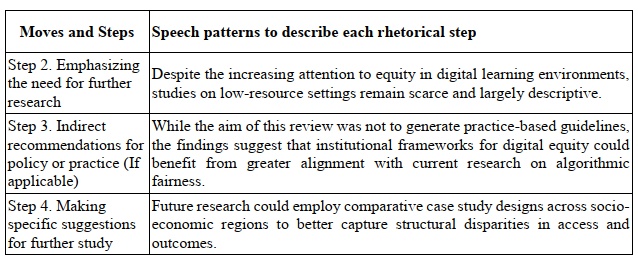
While the proposed typology offers a rhetorically coherent and genre-sensitive structure for the Discussion section, it is important to recognize that the actual layout of articles may be influenced by specific formatting requirements imposed by journals. For instance, the move of Deduction may appear in the Conclusion, or Limitations may be placed within the Methods section. Such shifts do not necessarily eliminate the rhetorical function of these elements but rather relocate them to other parts of the article. As a result, the typology should be understood as a flexible functional framework that can support authors' rhetorical decisions even when structural constraints are present.
Limitations
This study is subject to several limitations. First of all, the corpus was composed of articles from the leading educational journals ranked among the top 50 in the SJR index. While this ensures the high quality of the analysed material, it may also limit the generalisability of the findings, particularly to other disciplinary fields. Secondly, the analysis was conducted manually, which, despite a high level of inter-coder agreement, still allows for some degree of subjective interpretation. Furthermore, the study was limited to English-language publications, which excludes from consideration potential cultural and regional features of academic writing in other language traditions.
Despite these limitations, the findings allow us to propose a rhetorical model that may serve as a practical guide for authors, reviewers, and instructors of academic writing. A clearly structured Discussion section enhances not only genre coherence but also analytical argumentation. This is especially important given the growing number of publications adopting the scoping review format. Overall, this study shows that the scoping review genre requires its own rhetorical framework, focused not on the synthesis of evidence, but on the mapping of scientific knowledge. The development of such a framework is an important step towards formalising academic writing standards in rapidly evolving scholarly publication formats.
Conclusion
The present study aimed to systematically describe the rhetorical structure of the Discussion section in scoping reviews published in the field of education. Based on the analysis of a corpus of 50 papers selected from journals in the SJR first quartile, a functionally substantiated discussion model was reconstructed, including six rhetorical moves, each of them implementing a specific task in the genre logic of scoping reviews. The results of the study confirmed that, despite the existence of methodological guidelines for conducting scoping reviews, their rhetorical organization remains insufficiently regulated. Particularly vulnerable elements appeared to be those related to interpretation, comparison, and prediction, while the description of the field structure and discussion of limitations were performed stably in all analyzed texts.
The proposed model not only describes the current practice of writing the Discussion section in scoping reviews, but also serves as a basis for formulating genre recommendations necessary both for enhancing the rhetorical consistency of such publications and for teaching academic writing. The delineation of rhetorical functions between moves showed that typical errors of authors consist not in the absence of content, but in the violation of genre boundaries, namely, borrowing structures from systematic reviews, the absence of an interpretative component, or the substitution of analytics with a generalization of results.
Thus, the results of this study confirm the need to develop a stable rhetorical model for scoping reviews. Such a model not only contributes to increasing the genre transparency and quality of academic texts, but also strengthens the methodological independence of scoping review as a fully formed academic genre. In the future, it would be advisable to expand the analysis to other disciplines, as well as to study how differences in rhetorical strategies are related to the goals stated in the introduction and the structure of the Results section.
Declaration
This manuscript was refined using AI-assisted tools, specifically ChatGPT 4.0, to improve language clarity and coherence, since English is not native for the authors. AI was used for language editing. However, all conceptual arguments, analyses, and interpretations were developed independently by the authors.
Заявление
Текст рукописи был обработан при помощи инструмента ИИ ChatGPT 4.0 для улучшения ясности и связности языка поскольку авторы не являются носителями английского языка. Разработка концепции, анализ и интерпретация результатов реализовывались без опоры на ИИ.
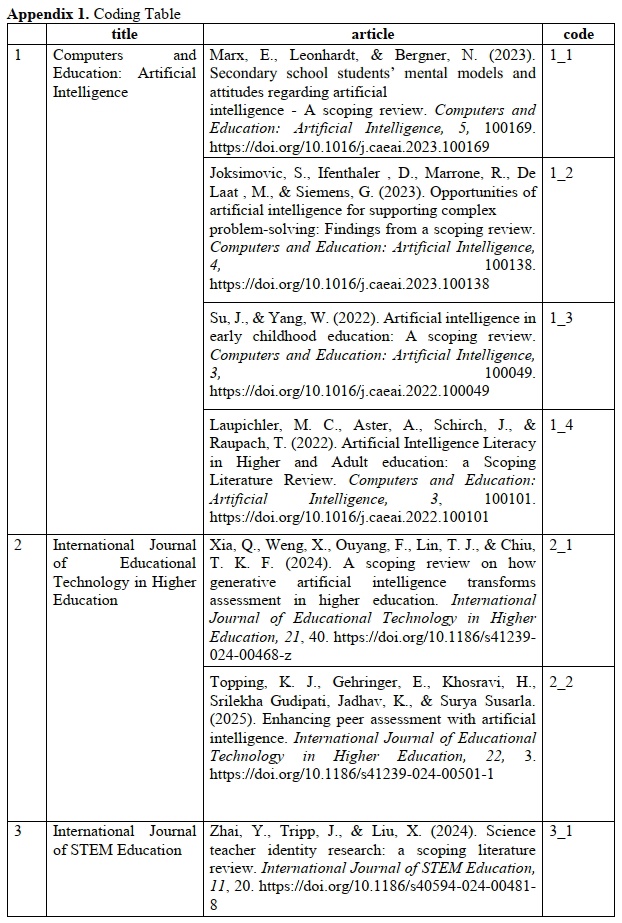

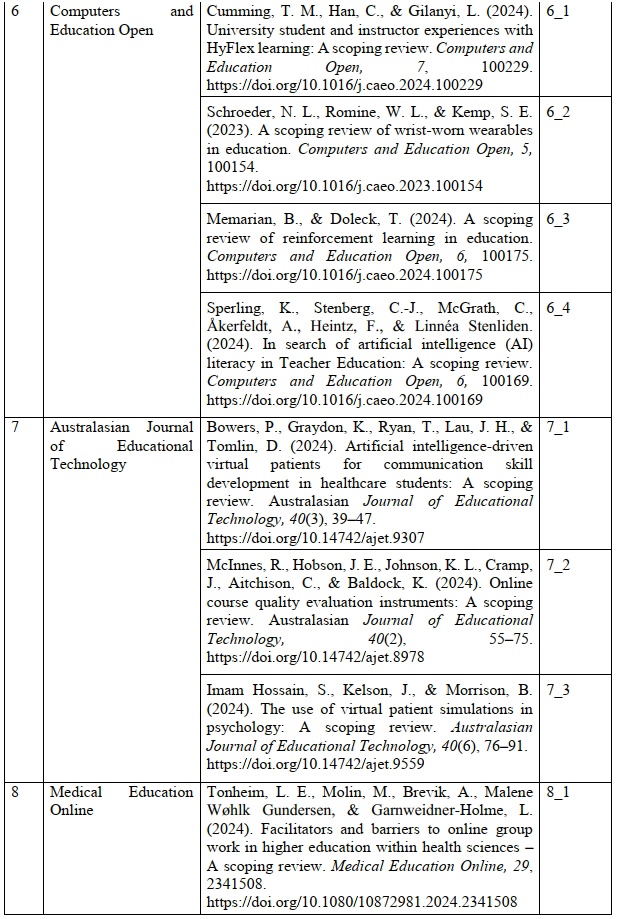
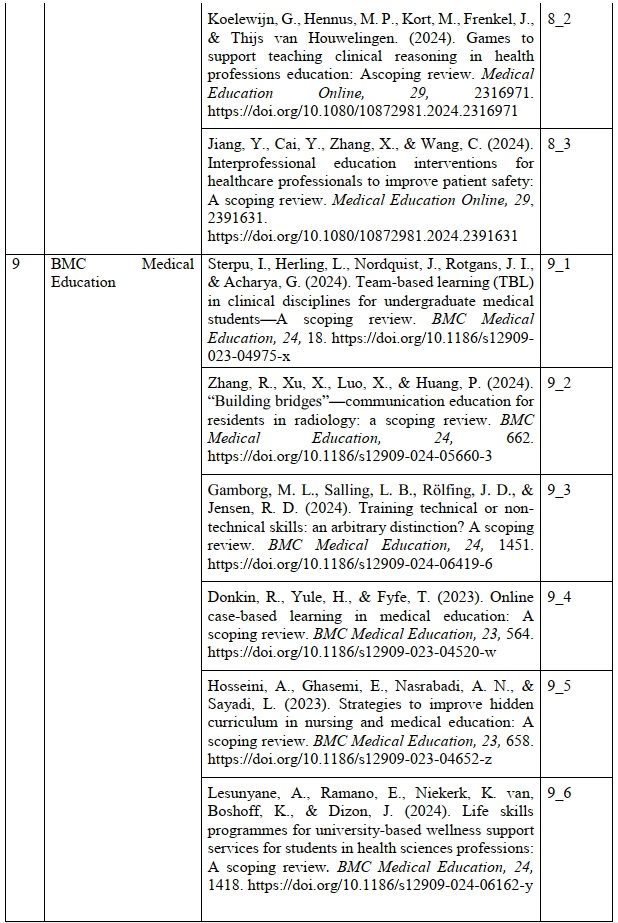
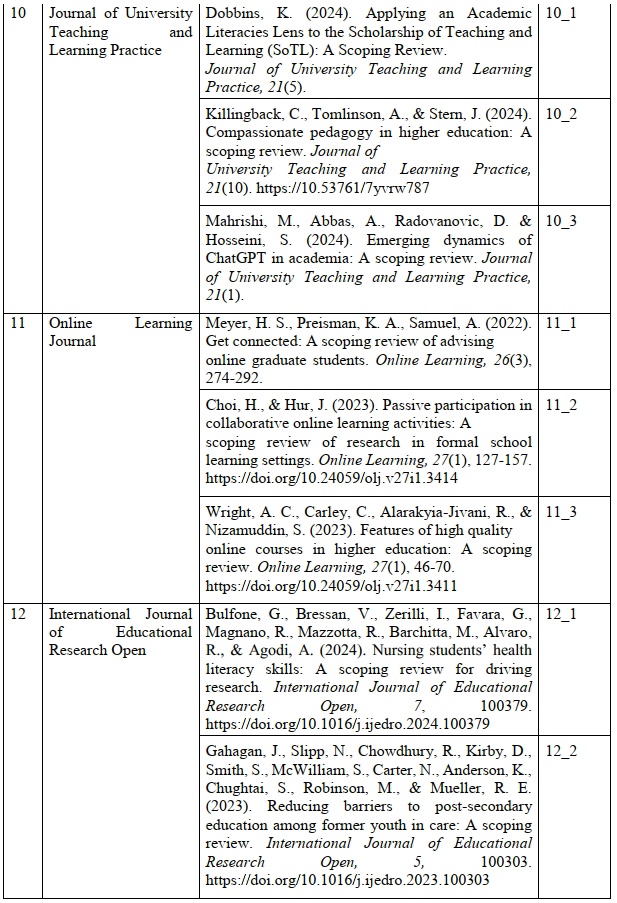
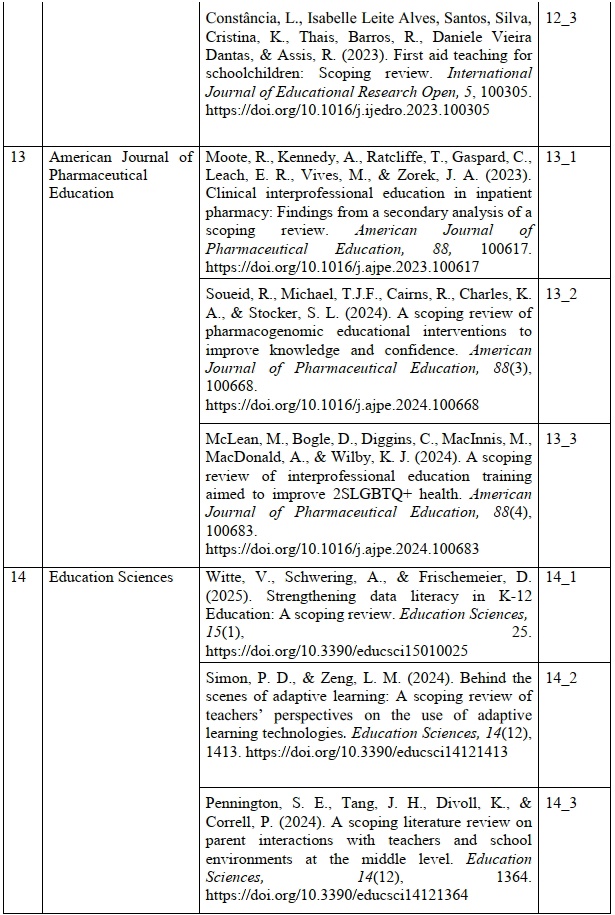
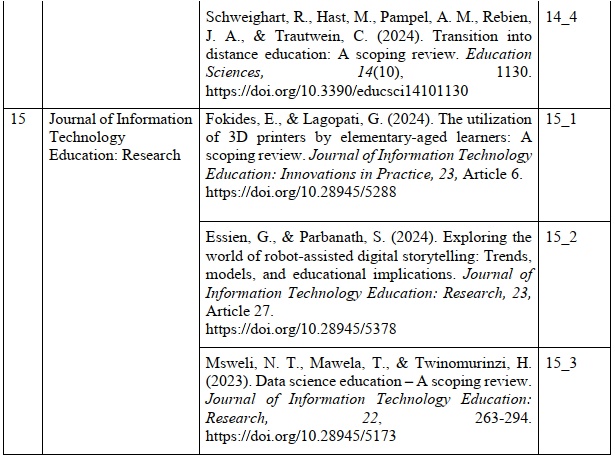
Appendix 2. Data Extraction Table
[1] PRISMA for Scoping Review. https://www.prisma-statement.org/scoping
[2] JBIManual for Evidence Synthesis. https://jbi-global-wiki.refined.site/space/MANUAL/355862497/10.+Scoping+reviews
[3] The table displays selected examples from the corpus, while the full dataset is available in Appendix 2.
[4] In some cases, the authors, on the contrary, include a limited assessment of quality and then explicitly note this as a deviation from the protocol norm, which also requires rhetorical support.
[5] Step 2 focuses on the importance and necessity of continuing research in general, as a response to identified gaps. It serves primarily to justify the need for further investigation in certain areas, without specifying how such research should be carried out. In contrast, Step 4 offers concrete suggestions—what should be studied, how, by which methods, and in what contexts. At this point, the author moves beyond merely asserting necessity and begins to articulate possible research trajectories. It is a shift from diagnosis to design. Step 2 performs an argumentative function, aiming to convince the reader that the existing body of knowledge is incomplete, fragmented, or limited. It serves as a rhetorical lead-in to the deductive component. Step 4, by contrast, fulfills an applied function: the author moves from identifying the problem to proposing potential solutions, thereby advancing the argument. This distinction is especially important in the context of a scoping review, where the logic of argumentation is based not on evidence synthesis but on the structural analysis of the research field. Accordingly, it is crucial first to delineate the gaps and only then to propose how they might be addressed.
[6] The exceptions are the papers in which the authors set out to include these review criteria and stated in explicitly in the Materials and Methods sections. In our corpus such cases were not registered.














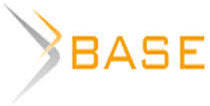



Список литературы
Список использованной литературы появится позже.